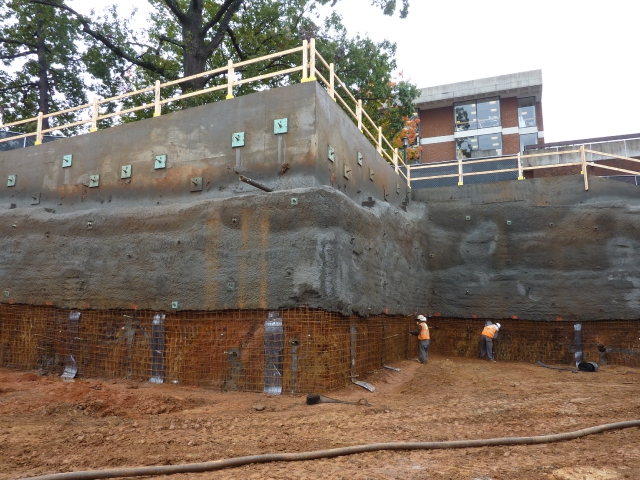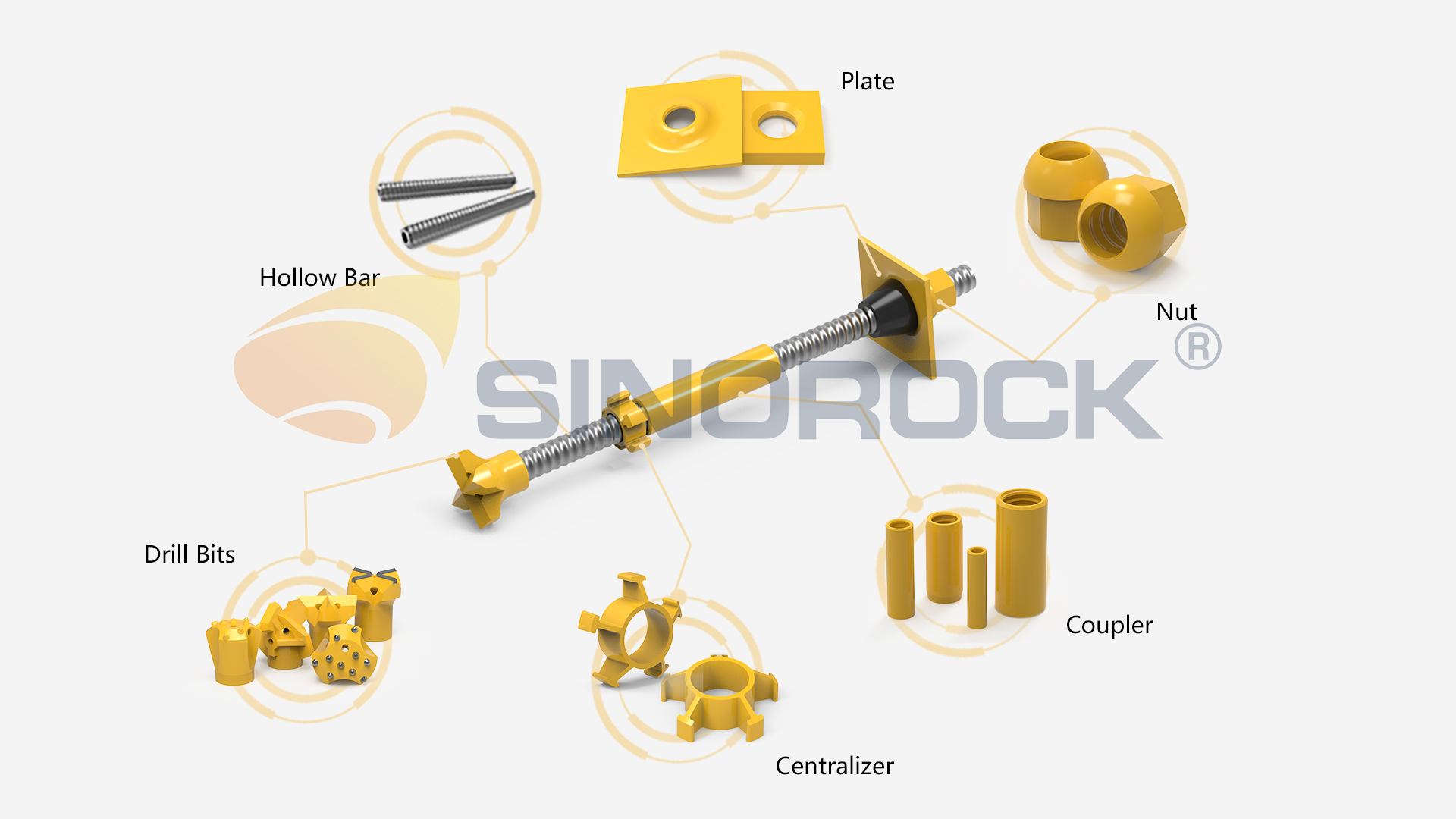Features Analysis of Deep Foundation Pit Construction
Time:2024-09-10From:sinorock View:
Deep foundation pit construction refers to the process of excavating and building a foundation pit that extends deep into the ground. This type of construction is commonly used for large-scale projects such as high-rise buildings, bridges, and underground structures. Deep foundation pit construction serves as the cornerstone of high-rise building projects, playing a pivotal role in ensuring the safety, stability, and longevity of these structures.
The Construction Process of Deep Foundation Pit Construction
1. Excavation: The ground is excavated to the desired depth using various methods such as drilling, blasting, or mechanical excavation.
2. Soil Stabilization: Depending on the soil conditions, stabilization measures may be necessary to ensure the stability of the pit walls. This can include techniques like soil nailing, grouting, or installing retaining walls.
3. Support Systems: Temporary support systems such as rock bolts, sheet piles, soldier piles, or diaphragm walls are installed to prevent the collapse of the excavation and to provide stability during construction.
4. Dewatering: If the excavation is below the water table, dewatering techniques are employed to remove groundwater and keep the pit dry.
5. Foundation Construction: Once the pit is stabilized, the foundation is constructed using various methods such as pile driving, caisson sinking, or drilled shafts. These deep foundations transfer the load of the structure to the stronger and more stable soil or rock layers below.
6. Backfilling: After the foundation is completed, the pit is backfilled with suitable materials to restore the ground to its original level.
Deep foundation pit construction requires careful planning, engineering expertise, and adherence to safety regulations. It is crucial to ensure the stability of the excavation, prevent soil or water ingress, and maintain the integrity of the surrounding structures during the construction process.

Features of Deep Foundation Pit Construction
1. Environmental Challenges and Temporary Nature
One of the foremost characteristics of deep foundation pit construction is its temporary nature. Throughout this phase, the construction site is exposed to a range of environmental challenges, including rainfall, solidification of piles, wind load, and mechanical vibrations. These factors can significantly impact the stability of the foundation pit slope, making it imperative for construction methods to account for these dynamic influences.
2. Localized and Context-Dependent Approaches
Deep foundation pit construction is inherently localized and context-dependent. Geological and hydrological conditions vary across different regions, necessitating the adaptation of measures to suit local circumstances. Before finalizing a supporting method, thorough assessments of the local conditions are carried out to ensure that the chosen approach is appropriate and effective.
3. Multidisciplinary Complexity
The comprehensiveness of deep foundation pit construction is marked by its multidisciplinary nature. The process involves considerations not only in structural mechanics but also hydraulics, making it a highly intricate endeavor. Specific engineering tasks encompass designing a robust supporting system, executing soil excavation, conducting inspections, and implementing continuous monitoring protocols.
4. Time-Space Solid Effect
The combined influences of depth, flat shape, and the soil's creep behavior result in a time-space solid effect within deep foundation pits. Over time, the excavation and construction activities induce stress changes that impact the surrounding soil and structures. Understanding and managing these effects is crucial to maintaining the stability and safety of the construction site.
5. Impact on Surrounding Structures
Deep foundation pit excavation can exert a considerable influence on nearby buildings and infrastructure. The confined workspace imposes stringent requirements on slope stability, potential impacts on surrounding structures, and the displacement of underground pipelines. Addressing these concerns demands meticulous planning and execution minimize potential risks.
Role of Self-Drilling Anchor Systems
Amidst these complexities, self-drilling anchor systems emerge as an invaluable solution to ensure the success of deep foundation pit construction projects. These systems amalgamate drilling, grouting, and anchoring processes, offering a streamlined and efficient approach to support and stabilization.

1. Efficient Installation
Self-drilling anchor systems facilitate swift and efficient installation processes. Their design integrates drilling capabilities, eliminating the need for pre-drilled holes. This expedites the installation process, reducing construction time and associated costs.
2. Deformation Prevention
Ensuring minimal deformation during deep foundation pit construction is pivotal. The nut of the self-drilling anchoring system is processed with a rounded surface at one end so that when there is a slight angle between the plate and the rock anchor bar, it can fit with the plate to ensure the transmission of force. If the angle is large, a domed nut or a domed plate can be used. The nut is equal in strength to the hollow anchor bar, which enhances the load-bearing capacity of the entire self-drilling anchor system and aids in preventing undesirable deformations in the surrounding soil and structures.
3. Structural Stabilization
The stabilization of the foundation is paramount for long-term safety and reliability. Self-drilling anchoring systems are securely anchored into stable soil or bedrock by the feature of grouting while drilling. This anchoring capability enhances the overall stability of the foundation pit.
4. Environmental Adaptability
The adaptability of self-drilling anchor systems to diverse soil and geological conditions is a significant advantage. Whether dealing with varying soil types or challenging terrains, these systems can be tailored to meet specific project requirements.
Summary
In conclusion, deep foundation pit construction is a complex endeavor marked by its temporary nature, regional specificity, multidisciplinary nature, and impact on surrounding structures. In navigating these challenges, self-drilling anchor systems stand as a pivotal solution, streamlining installation processes, preventing deformations, stabilizing structures, and adapting to diverse environments. As construction practices continue to evolve, the integration of innovative technologies like self-drilling anchor systems will play an increasingly crucial role in ensuring the safety, stability, and longevity of deep foundation pit projects.
As a professional manufacturing self-drilling anchor bolts, Sinorock's team has many years of experience in providing complete geotechnical engineering services. If you have any needs or questions about self-drilling anchor systems, please feel free to contact us at sinorock@sinorockco.com.
latest news
-

- What Are the Applications of SDA Bolts in Hydropower Stations?
- Time:2025-08-21From:This Site
- Learn how self-drilling anchor bolts enhance slope stability, tunnel support, and dam reinforcement in complex geological conditions at hydropower stations. Optimize hydropower projects with efficient, cost-effective, and eco-friendly solutions.
- View details
-

- Slope Stabilization with SDA Bolts: Benefits & Applications
- Time:2025-08-19From:This Site
- Discover how self-drilling anchor bolts (SDA bolts) provide superior slope stabilization for highways, railways, and tunnels. Learn their key benefits, installation process, and real-world applications in loose or collapsible soils.
- View details
-

- How Self-Drilling Rock Bolts Enhance Tunnel Support in Fractured Rock?
- Time:2025-08-15From:This Site
- Discover how self-drilling rock bolts enhance tunnel support in fractured rock. Learn their benefits, installation steps, and real-world applications for safe, efficient tunneling.
- View details
-

- Sinorock 2025 Quality Month | Strengthening Quality Foundations, Empowering Product Excellence
- Time:2025-08-13From:This Site
- Sinorock’s 2025 Quality Month, themed “Strengthening Quality Foundations, Empowering Product Excellence,” successfully concluded, reinforcing our commitment to superior product quality.
- View details
-

- Sinorock Safety Month 2025 | Everyone Speaks Safety, Everyone Can Respond
- Time:2025-07-03From:This Site
- Sinorock Safety Month 2025, centered on the theme "Everyone Speaks Safety, Everyone Can Respond - Spot Workplace Hazards," has wrapped up successfully!
- View details
-

- Quality Control: the Vital Factor of A SDA Bolt Factory
- Time:2025-01-09From:This Site
- Sinorock’s comprehensive quality control system, from supplier management to outgoing inspections, ensuring the highest standards for self-drilling anchor bolts in construction.
- View details
-

- Sinorock Invites You to Explore Proven Self-Drilling Anchor Bolt Solutions at bauma 2025
- Time:2025-03-07From:This Site
- From April 7–13, 2025, explore Sinorock’s Self-drilling anchor bolt solution at Booth C2.513/4 in Hall C2 of the Messe München Exhibition Center (Munich, Germany).
- View details
-
.jpg)
- SINOROCK to Attend EXPOMINA PERÚ 2024 in Lima, Peru
- Time:2024-08-10From:This Site
- Sinorock to Attend EXPOMINA PERÚ 2024 in Lima, Peru
- View details
-
.jpg)
- SINOROCK to Participate in MINING AND METALS CENTRAL ASIA 2024
- Time:2024-08-08From:This Site
- SINOROCK to Participate in MINING AND METALS CENTRAL ASIA 2024
- View details
 Download
Download 


